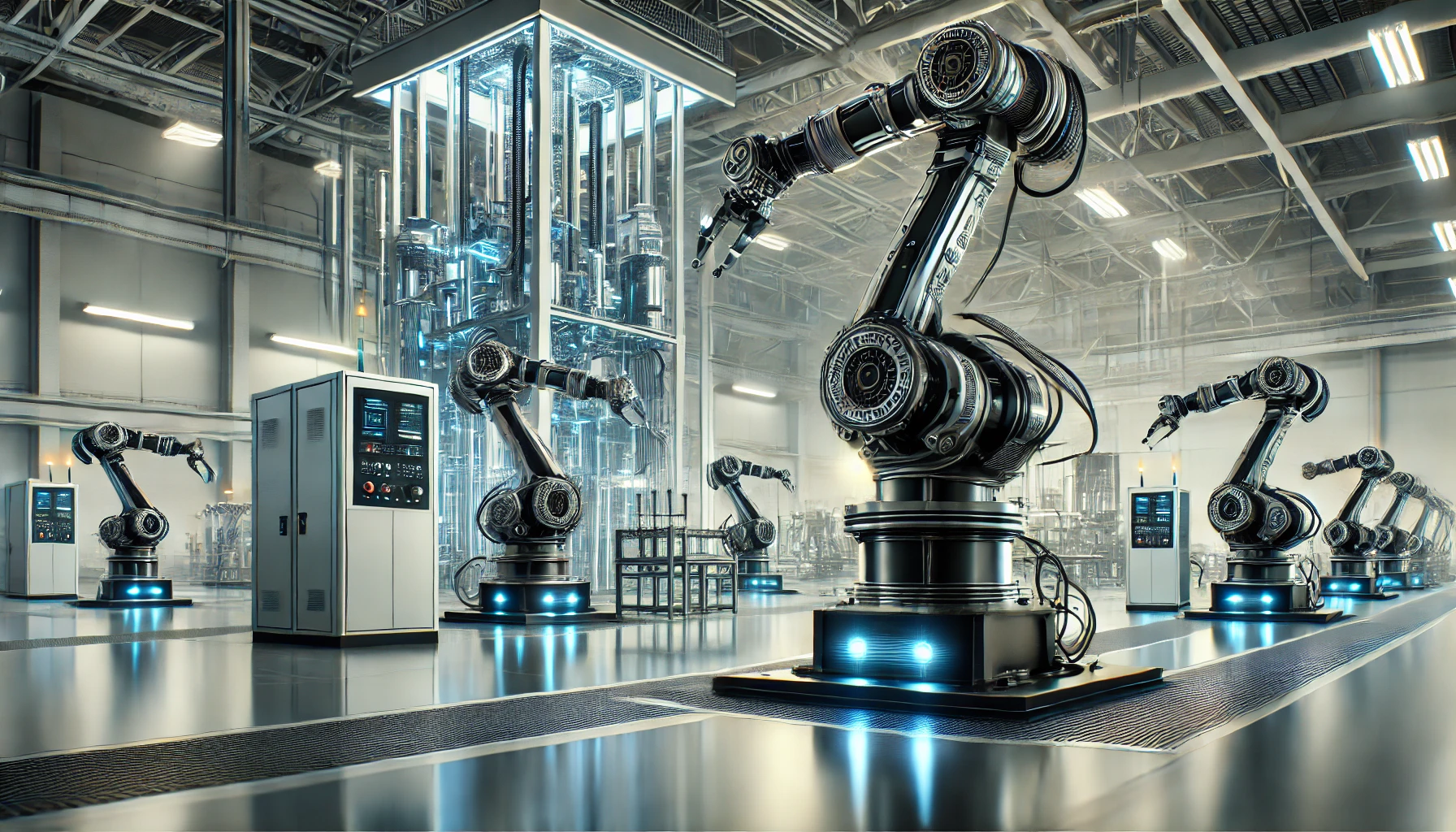The Need for Energy Efficiency in Manufacturing
The manufacturing industry is one of the largest energy consumers globally, and as pressure mounts to reduce carbon emissions, businesses are increasingly seeking innovative ways to become more energy-efficient and sustainable. Achieving energy efficiency is not only crucial for reducing operational costs, but it’s also a key strategy in decarbonising manufacturing processes and meeting corporate sustainability goals.
One of the most impactful tools for achieving this goal is Artificial Intelligence (AI). By integrating AI into energy management systems, manufacturing companies can optimise energy consumption, reduce waste, and improve overall efficiency. In this article, we’ll explore how AI is transforming the manufacturing sector’s approach to energy efficiency, offering practical insights into how AI can be harnessed for decarbonisation.
AI-Powered Predictive Maintenance: Maximising Equipment Efficiency and Reducing Energy Waste
The Problem: Inefficient Equipment and Unplanned Downtime
In manufacturing, equipment is critical to production. But when machines fail unexpectedly or run inefficiently, the consequences are far-reaching: production stops, orders are delayed, and repair costs quickly escalate. These issues are not just inconvenient – they also waste vast amounts of energy. A machine running at less-than-optimal performance can use more energy than necessary, leading to higher energy bills and a larger carbon footprint.
Manufacturers often rely on traditional maintenance practices, which either wait for equipment to fail or schedule maintenance at fixed intervals regardless of the equipment’s condition. But these methods can miss early signs of inefficiency or preventable failure, causing unnecessary costs and wasted energy.
This is where Artificial Intelligence (AI) steps in.
How AI-Powered Predictive Maintenance Works
Data Collection Through IoT Sensors
The first step in AI-powered predictive maintenance is data collection. Sensors are installed on machines throughout the manufacturing plant to collect operational data, including temperature, vibration, pressure, and energy consumption. These sensors feed data into AI systems, which constantly analyse and learn from the information.
For instance, a sensor on a motor might track its temperature. If the motor starts running hotter than usual, the AI system would flag this as a potential issue, even before a physical malfunction occurs. This early detection helps prevent costly repairs and energy waste.
Machine Learning Algorithms: Learning to Predict Failures
Machine learning algorithms play a critical role in predictive maintenance. These AI models process the data collected by the sensors, looking for patterns and anomalies that indicate a machine might be heading toward failure or inefficiency. Over time, the AI learns from the data, improving its predictions and providing even more accurate maintenance schedules.
For example, if the AI system notices that a particular valve is consuming more energy due to a slight misalignment, it can predict when it will likely fail or need maintenance. It can then schedule repairs ahead of time, avoiding both the failure and the excess energy consumption.
Continuous Monitoring and Real-Time Adjustments
One of the most significant advantages of AI-powered predictive maintenance is its ability to monitor equipment continuously. While traditional maintenance only takes place at set intervals, AI can track real-time performance and make adjustments as needed. If the system detects an inefficiency, it can alert technicians to fix the issue immediately, often before it even affects production.
For example, an AI system might notice that a fan motor is running less efficiently, consuming more energy to maintain the same airflow. The system will immediately alert the maintenance team to address the issue before it wastes more energy or leads to a breakdown.
The Benefits of AI-Powered Predictive Maintenance
1. Reducing Unplanned Downtime
The most obvious benefit of AI-powered predictive maintenance is the reduction of unplanned downtime. Machines that are well-maintained run more efficiently and have a lower likelihood of unexpected failure. By identifying potential problems early, AI enables manufacturers to schedule repairs before a failure occurs, thus avoiding production stoppages.
For manufacturers, downtime is costly. Every minute a machine is out of operation is money lost. Predictive maintenance reduces this risk by ensuring equipment runs at its best, preventing unnecessary downtime, and keeping production running smoothly.
2. Extending Equipment Life
When machines run inefficiently or are not properly maintained, their lifespan is shortened. Excessive energy use and strain on components can lead to faster wear and tear, meaning businesses must replace costly equipment sooner than expected. AI-powered predictive maintenance helps extend the life of critical machinery by identifying issues before they cause permanent damage.
Instead of waiting for a piece of equipment to fail and require expensive repairs or replacement, predictive maintenance helps ensure that everything is functioning optimally. Over time, this can result in significant savings on replacement costs and improve the return on investment (ROI) for manufacturing assets.
3. Enhancing Energy Efficiency
An often overlooked benefit of predictive maintenance is its ability to improve energy efficiency. When machines are poorly maintained, they consume more energy to perform the same tasks. Think of a motor running at lower efficiency because of worn-out parts or an air compressor that’s overworking due to a small leak. These inefficiencies not only increase energy costs but also add to the carbon footprint of the factory. AI-powered predictive maintenance ensures that machines are running at their optimal energy levels, reducing both energy consumption and the environmental impact.
For example, an AI system might detect that a pump is drawing more energy due to a worn-out seal, allowing it to be replaced before the pump consumes excessive energy.
This proactive approach not only reduces energy costs but also lowers the carbon emissions associated with unnecessary energy consumption.
4. Reducing Maintenance Costs
Maintaining equipment before it fails can save manufacturers a significant amount of money. By avoiding unexpected repairs and reducing the likelihood of expensive breakdowns, AI-powered predictive maintenance lowers overall maintenance costs. Additionally, because AI systems schedule repairs based on data-driven insights, they help optimise the use of maintenance resources, ensuring that repairs are only performed when necessary.
Manufacturers can save money by ensuring that resources are used efficiently, with minimal waste. This approach also helps reduce the need for emergency repairs, which are typically more expensive than routine maintenance.
Real-World Example: Predictive Maintenance in Action
Imagine a factory that relies on several critical machines, such as compressors, motors, and conveyor belts. These machines run constantly, and even small inefficiencies can lead to wasted energy and increased costs. With AI-powered predictive maintenance, the factory can track each piece of equipment in real time, using sensors to monitor performance.
If a compressor begins to show signs of wear, such as increased vibration or rising temperature, the AI system will flag the issue. The maintenance team is alerted, and they can replace the faulty part before it causes a complete failure. In this scenario, not only is downtime avoided, but energy waste is prevented, and the compressor’s lifespan is extended.
By proactively managing the health of each machine, the factory can reduce energy consumption, lower maintenance costs, and minimise the risk of unplanned downtime. All of this contributes to a more sustainable, energy-efficient operation.
Incorporating AI-powered predictive maintenance is a powerful step towards reducing carbon emissions in manufacturing. By monitoring equipment in real time, predicting failures before they happen, and improving energy efficiency, businesses can reduce operational costs, extend the life of equipment, and minimise waste – all while contributing to sustainability goals.
With AI transforming the way manufacturers approach maintenance, the opportunity to decarbonise and improve energy efficiency is within reach. For companies committed to achieving their sustainability targets, AI-powered predictive maintenance is an essential tool for building a greener, more efficient future.

